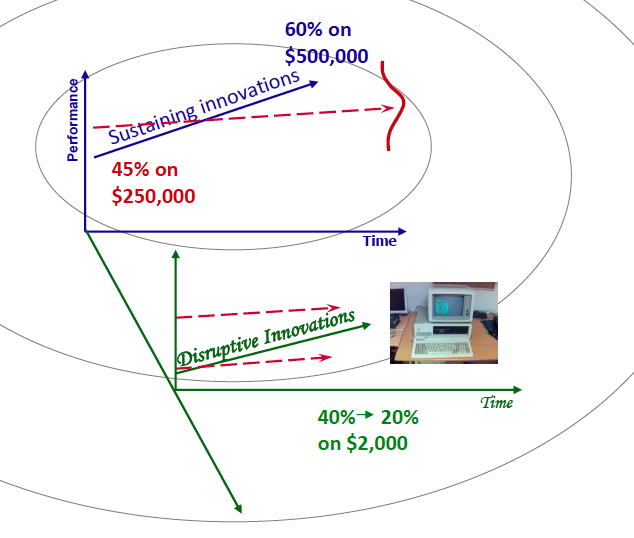The agenda was filled with a great list of speakers, innovators and visionary thinkers. The early part of the day was inevitably slanted towards the results of the ruling but interestingly many of the speakers commented that even though they had an opportunity to change their presentation and adjust based not he ruling most did little to change their overall message commenting that no matter the decision the innovation and march forward of HealthIT continued apace.
There were some notable ideas on how to achieve innovation through disruption that has repeated itself through history in many industries. The computer industry started with a centralized model with mainframes and slowly decentralized providing increasing access at lower and lower costs to mini-computers, personal computers and now mobile devices. Agile companies had to innovate accepting the change and focusing on the next wave - those that did not were left behind often disappearing entirely from the playing field
decentralization through disruption leads to accessibility

Disruptors leap frog their competition and in a telling comment from Jason Hwang
"If you are wildly successful and innovative, you are doomed"
In healthcare the same principles are in play. We have centralized healthcare system with hospitals, surgical centers, data collection from laboratories and imaging facilities but these activist and resources are being decentralized as we move to local clinics, retail clinics, home care and the individual engagement of consumers in home healthcare that does not always necessarily nor need to be delivered by a physician.
This move away form centralized care should not be feared but rather embraced as an opportunity to survive and thrive in the new economy. The key to survival is to disrupt your own business model and engage in offerings that replace the current methods and systems. Clinicians often fear and object to their removal form all care processes but we have seen this applied in a number of areas already (Nurse Anesthetists, Nurse Practitioners) and as technology improves and patient become more engaged we see more routine activities being ceasing to be the eminent domain of physicians.
Our use of technology should not just be limited to making our current processes and care givers better at what they do but should allow for others to deliver the routing care reserving the highly trained and experienced professional for the complex and non-standard elements. Dr Hwang cited the example of the surgical robots in use today that are currently making surgeons better but suggested that instead we should be thinking about how this technology can make non-surgical staff able to do routing surgical procedures. For many clinicians this would be deemed the think end of the wedge but if history is any guide, as it often is, this will be part of or future and indeed I have seen the potential of this. I was in a virtual minimally invasive training center with a 16 year old high school student who had been given the opportunity to take on the virtual course work as part of work experience. I watched in amazement as the student blazed through the initial courses that taught a range fo skills necessary to perform a laprascopic cholecystectomy. So much so it made it look easy. This culminated in a simulated version of the procedure which I watched the student do. Fooled into thinking this was just easy I attempted a small portion of the course and failed to progress at anywhere the rate or with the adeptness that I had just watched.
No - this high school student could not do a Laprascopic Cholecystectomy but what this clearly showed in my mind was that with the application of technology & training we will find individuals that will be highly suited and finely tuned to perform routine procedures. We already see this with the military machine and surveillance drone pilots who are not pilots in the current sense of that term but can and do fly complex aircraft albeit remotely and from the ground
In fact Dr Hwang quoted Dr Warner Slack
"Any Doctor who can be replaced by a computer should be"
You can see one of his presentations How Disruptive Innovation Can Fix Health Care
Innovation is coming in many different forms and to survive and thrive we do need to embrace it, not at the expense of quality and safety but neither of these need be compromised with innovative application of disruptive technology. We see some of this going in the speech world as we move away from traditional transcription with back end speech recognition and the increasing penetration of front end technology that provides real time results. Layered over this is Natural Language Processing Technology (NLP) or Clinical Language Understanding (CLU) that provides medical intelligence to the words offering further enhancement to the interaction. We have seen this concept adeptly applied byApple with Siri which takes account of context, understand intent and offers a voice interface that has an inbuilt Artificial Intelligence. Siri has disrupted the mobile interactions and these techniques and tools offer disruptive innovation opportunities to healthcare that I expect will emerge in the coming months.
These are exiting times and I came away with a sense of great fortune to be here at this time to witness innovation and the excitement as we watch HealthIT explode in the healthcare sector
Here's the Slideshare version of his presentation
No comments:
Post a Comment
Note: Only a member of this blog may post a comment.